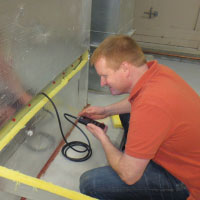Are meetings a waste of time? Deriding them as such is common. But with some upfront effort, meetings can deliver outcomes that would otherwise take much longer to achieve.
 Photo by Flickr user Highways Agency England
Photo by Flickr user Highways Agency England
I’ve had a couple of instances lately when I’ve had the opportunity to step up and help meetings run more smoothly. Here are my formulae for success in a couple of common meeting types in the energy efficiency industry.
Meeting Type – Regular Project Team Meetings with Client
- Write an agenda at least 24 hours in advance and send it out
- Agenda 101
- Action items go at the top of the agenda to enable easy review and updating of actions
- Put most important topics first
- Estimate the time required/allowed for discussion of topics
- Be clear on the purpose for covering a topic
- Decision
- Share information
- Identify key questions or unknowns
- Plan next steps or actions to advance
- Optional – make two agendas:
- Short form share with attendees
- Detailed agenda includes all your notes to help you facilitate and guide the dialog.
- Agenda 101
- During the meeting monitor time spent on each topic and check in with your client to ensure they are comfortable with shifts in the agenda as they occur.
- Ensure everyone’s voice is heard and that no one dominates the conversation.
- Take notes of all decisions, assignments, action items and deadlines.
- Review the action items before the end of the meeting.
- Publish an action items list immediately after the meeting – this list summarizes the action items, responsibility and deadline so that the attendees are accountable. I usually send this in the body of an email so everyone has easy access.
- Publish the meeting minutes within 24 hours of the meeting – put the action items at the top of the minutes.
- When you prep for your next meeting, review the action item list, send reminders to anyone who has actions due by the next meeting and ensure you’ve completed all of your assigned tasks and send out any work products at least 24 hours before the meeting.
I had my first experience with a well facilitated meeting as a teenager when we were planning a family trip to New York City and my parents wanted to take everyone’s interest into account. The family listed all of the things we wanted to do and then we voted. In addition to the general voting, my Dad made sure that at least one thing added by each person got on the action item list. On that trip we went to see The Wiz, an off Broadway show, the Guggenheim, a park to play, FAO Schwartz, and ate at the Tavern on the Green. It was a great trip and everyone was pretty happy the whole time. So I learned at a relatively early age the benefit of a well-run planning exercise and have had the opportunity to run many of them myself.
Meeting Type – Planning Meeting

- Planning meeting agendas should be prepared at least a week in advance and any homework assigned at that time along with agenda distribution.
- Planning meetings require strong facilitation and organization in order to be successful.
- Clearly define the meeting objective
- Clearly define the process for idea generation and refinement. The process I like best is brainstorming. Brainstorming requires rules – here are my go-to rules for brainstorms:
- Give everyone 2 minutes to silently develop responses.
- Go round robin – with each person in the room giving one response at a time until all responses have been unearthed.
- No discussion (other than clarification). Brainstorming is to get ideas out, it is not the time for refinement.
- Building on other ideas is one of the benefits of brainstorming.
- There are no bad ideas, don’t allow anyone to be shut down.
- Write all ideas on flip charts – I like to alternate pen colors to assist with legibility. Label charts with the topic and number the pages.
- Once you’ve got the list of ideas on the flip chart take five minutes to look for groupings or overarching topics. If you can group ideas easily, do so, if not move on to prioritization of the aggregate list.
- To group topics – establish your categories and assign a letter to each. Run through the brainstorm list and have people in the room tell you which category letter to assign.
- Prioritization – I like multi-voting to set priorities
- Multi-voting: each person receives three colored dots: blue is 5 points, red is 3 points and yellow is one point. They rank their top three items. If items have been grouped you can rank top three or fewer in each group.
- In a recent meeting in which we categorized, the group was able to reach consensus on the ranking of the items within each category without multi-voting. I think this is rare, but it was pretty cool to have the group work so smoothly together.
- Another note on prioritization is that you may want to spend some time defining the criteria by which you are establishing the priority. Most important to our mission is a good one, but make sure everyone is coming from the same place for this exercise.
- Review the priorities to ensure the outcomes make sense to the group
- Agree on next steps to develop an action plan.


